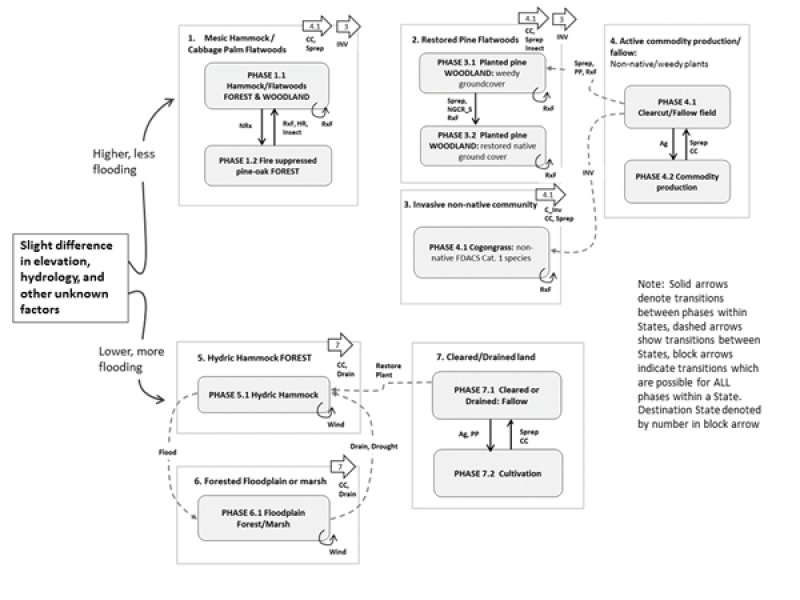
Natural Resources
Conservation Service
Ecological site F154XA011FL
Wet Lithic Flatwoods And Hammocks
Last updated: 3/24/2025
Accessed: 12/21/2025
General information
Provisional. A provisional ecological site description has undergone quality control and quality assurance review. It contains a working state and transition model and enough information to identify the ecological site.
MLRA notes
Major Land Resource Area (MLRA): 154X–South-Central Florida Ridge
This MLRA makes up about 7,209 square miles (18,672 square kilometers) and is entirely in Florida. MLRA 154 contains a series of parallel, prominent sandy ridges of Pleistocene marine origin, including the Brooksville and Mount Dora Ridges. These north to south oriented parallel ridges are interspersed with more low lying physiographic provinces, including: upland hills, plains, valleys and gaps (Puri and Vernon 1964).
Many of the soils in this sub-unit are Pleistocene or Holocene sands that are underlain with older, loamy Pliocene marine sediments (Cypresshead formation) or the clayey Miocene marine sediments (Hawthorne formation). A combination of marine depositional events and the dissolution of underlying limestone (karst geology) is responsible for surficial topography throughout Peninsular Florida.
Classification relationships
All portions of the geographical range of this site falls under the following ecological / land classifications including:
-Environmental Protection Agency’s Level 3 and 4 Ecoregions of Florida: 75 Southern Coastal Plain; 75c Central Florida Ridges and Uplands (Griffith, G. E., Omernik, J. M., & Pierson, S. M., 2013)
-Florida Natural Area Inventory, 2010 Edition: Mesic Hammock, Hydric Hammock, Floodplain Swamp, and Floodplain Marsh (FNAI, 2010)
Ecological site concept
The central concept of the Wet Lithic Flatwoods and Hammocks includes shallow or moderately deep, poorly drained alkaline soils that have a sandy or loamy subsoil. All soils of this site occur in flat landscapes (<2% slope) and have limestone bedrock is within 40 inches of the soil surface. This concept includes shallow, sandy or loamy, poorly drained soils (Demory, Hallandale, Waccasassa, Wekiva series), and moderately deep, loamy, poorly drained soils (Boca series). This site is exclusive to the Coastal Marshes, Gulf Coastal Lowland, and the Tsala Apopka Plain physiographic units.
Associated sites
| F154XA007FL |
Moist Sandy Wet-Mesic Flatwoods This site is on similar drained soils that will have lithic contact deeper than 152 cm |
|---|---|
| F154XA012FL |
Wet Rich Forests And Woodlands This site is on similar drained soils that will have lithic contact deeper than 152 cm |
Similar sites
| F154XA010FL |
Moist Lithic Flatwoods And Hammocks This site Is on better drained soils that will influence changes in the types and amounts of vegetation present |
|---|
Table 1. Dominant plant species
| Tree |
(1) Quercus virginiana |
|---|---|
| Shrub |
(1) Carpinus caroliniana |
| Herbaceous |
(1) Chasmanthium laxum ssp. sessiliflorum |
Click on box and path labels to scroll to the respective text.


